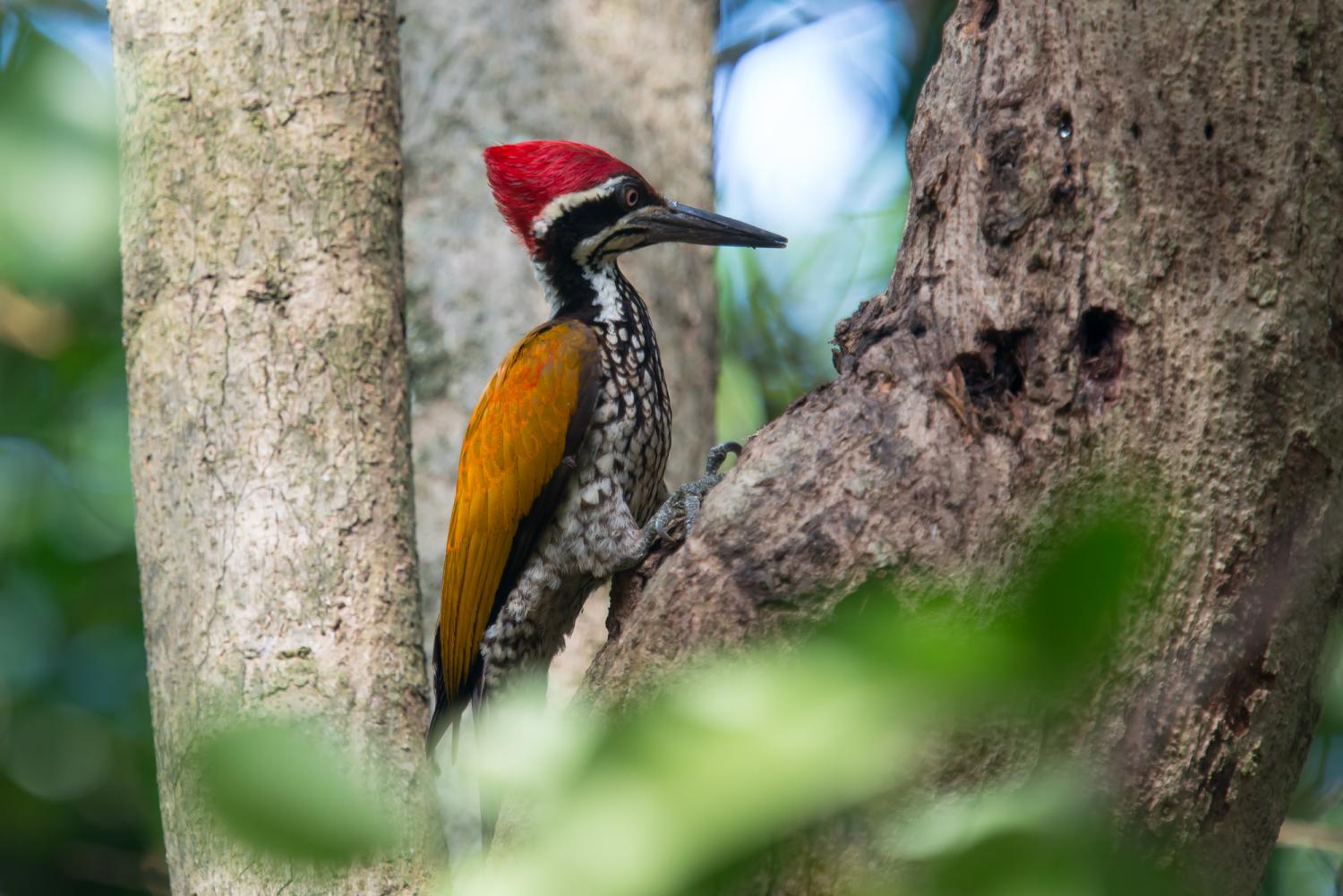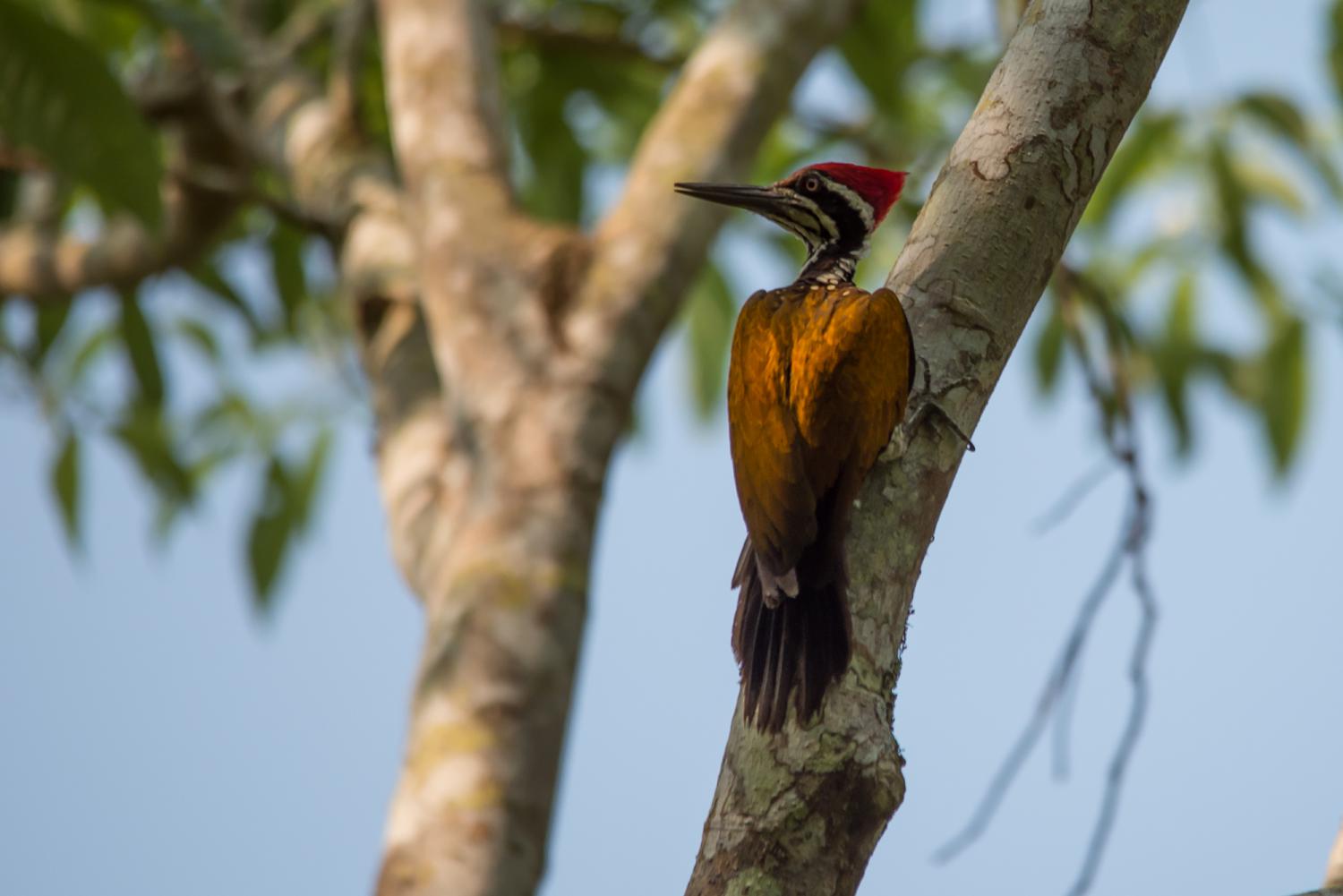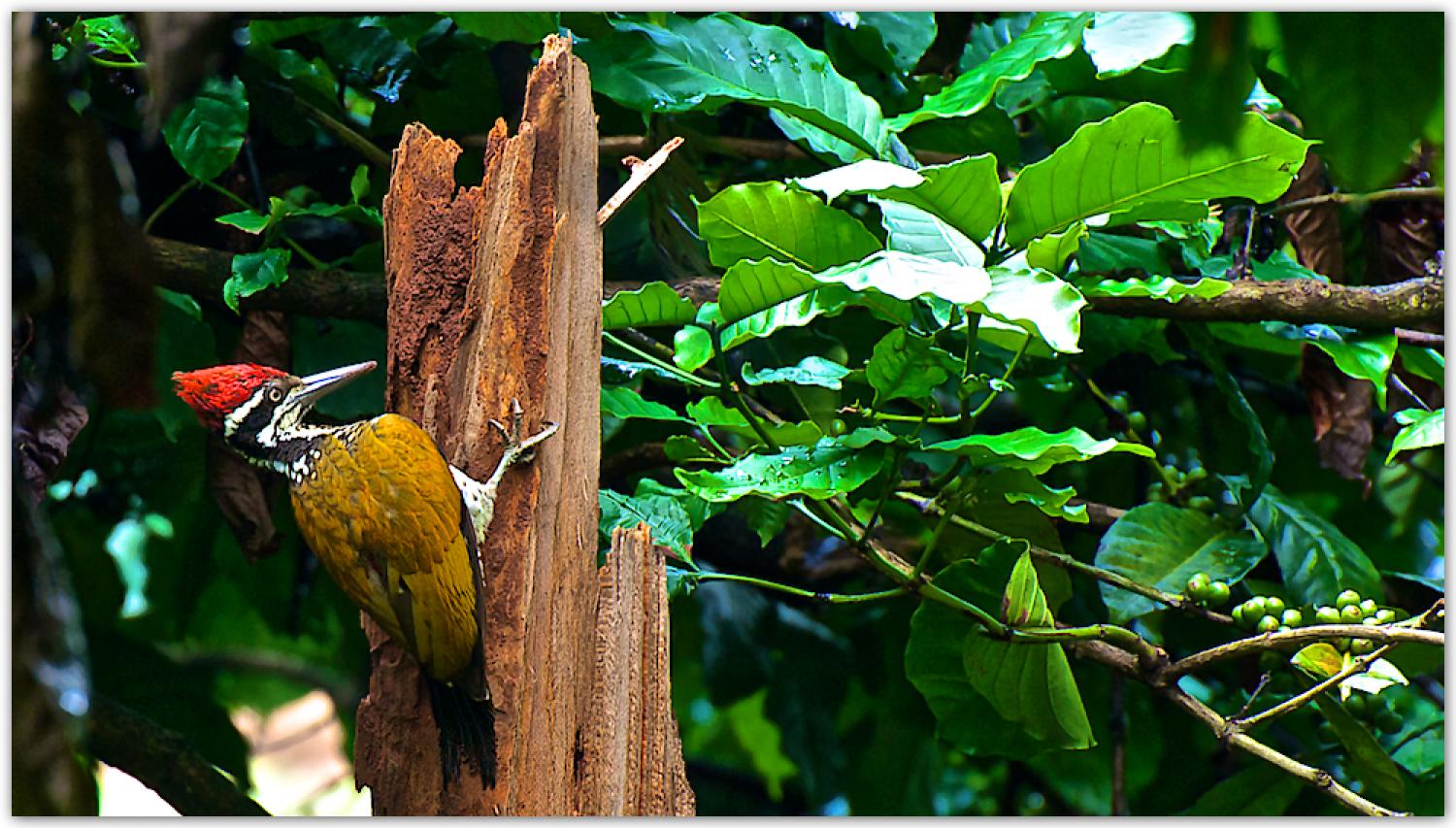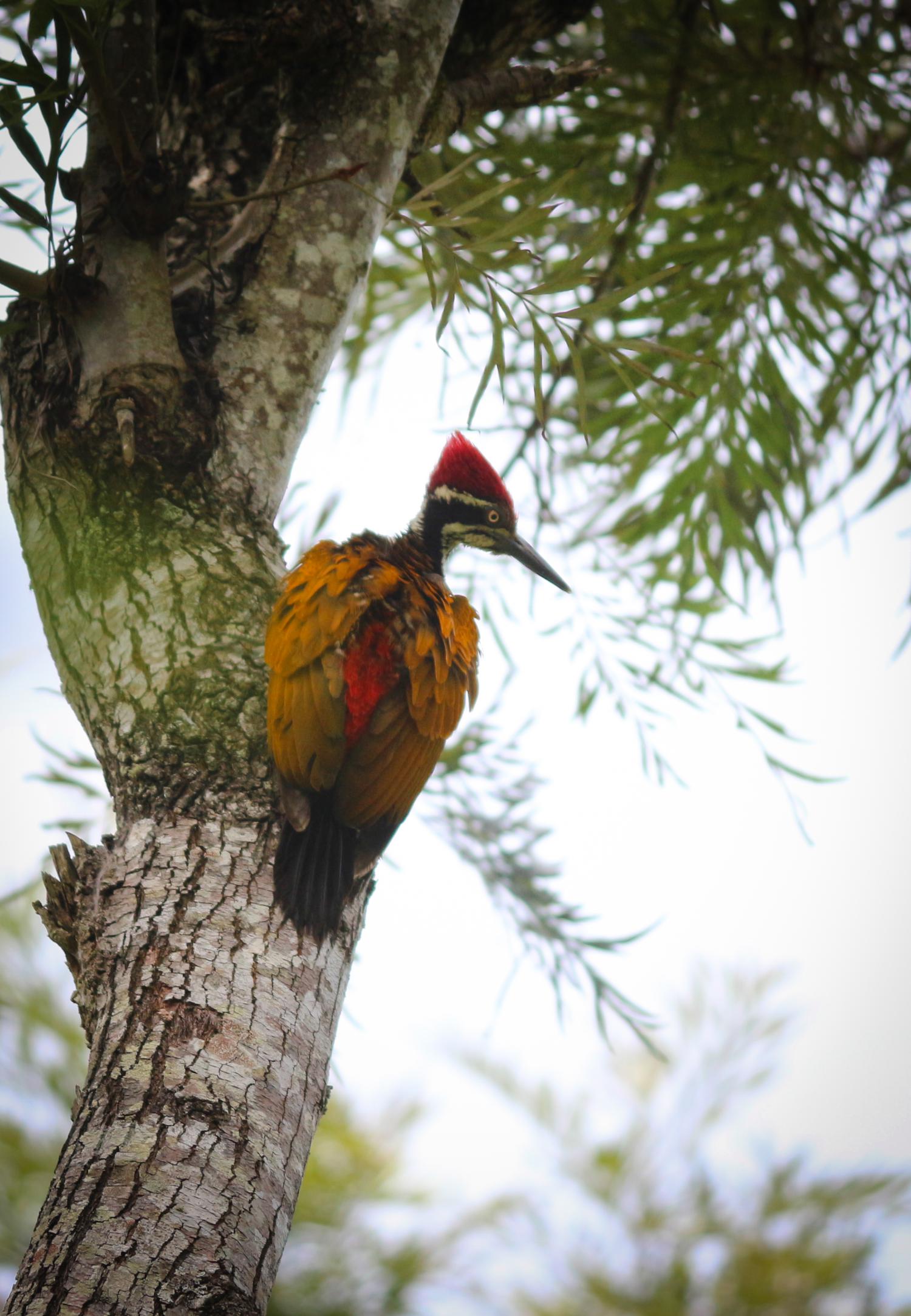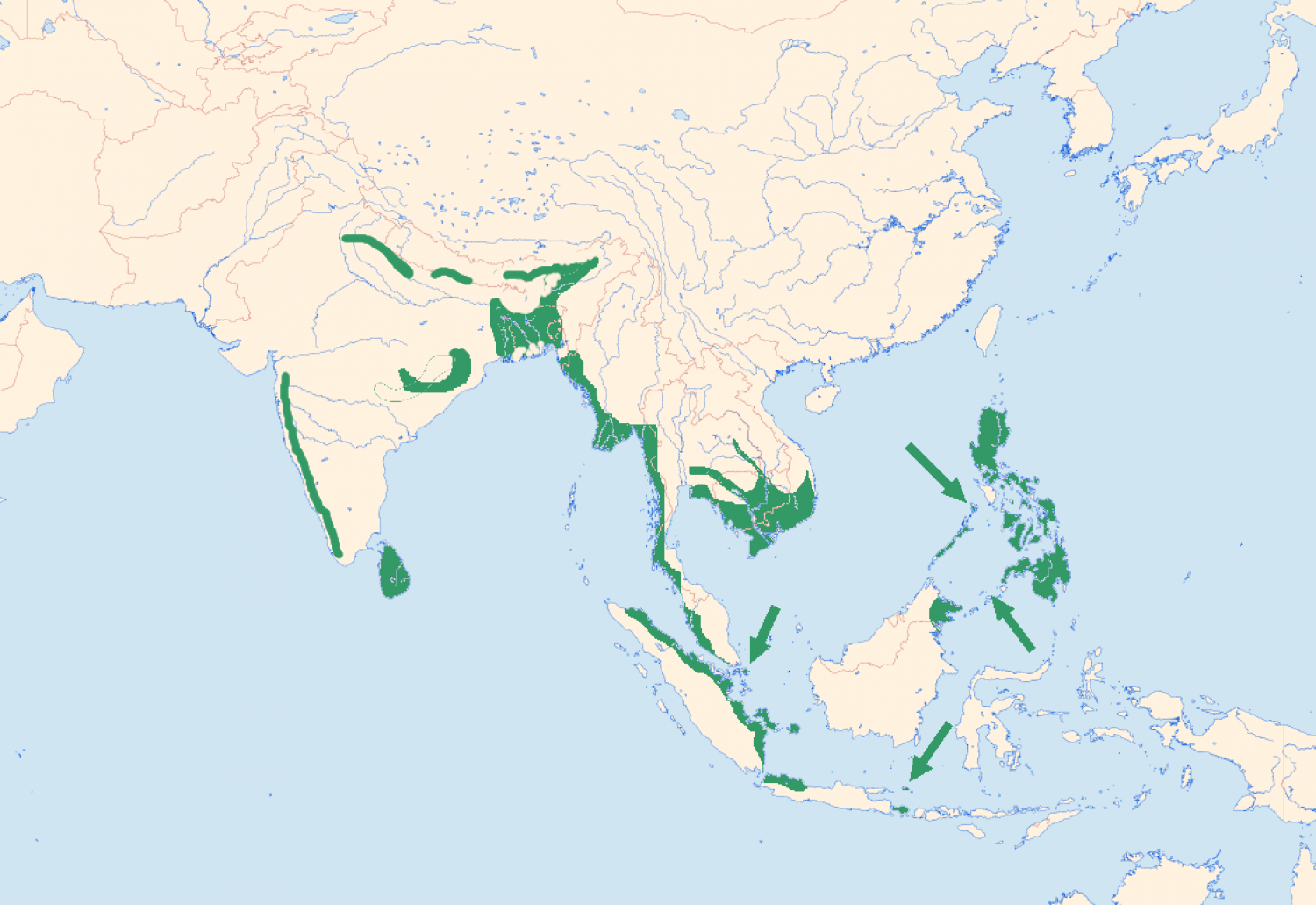Species of Thailand
Greater flameback
Chrysocolaptes guttacristatus
Samuel Tickell, 1833
In Thai: นกหัวขวานสี่นิ้วหลังทอง
The greater flameback (Chrysocolaptes guttacristatus) also known as greater goldenback, large golden-backed woodpecker or Malherbe's golden-backed woodpecker, is a woodpecker species. It occurs widely in the Indian subcontinent, eastwards to southern China, the Malay Peninsula, Sumatra, western and central Java and northeast Borneo.
Taxonomy
Recent taxonomic evidence suggested the species be split into the following species:
- Greater flameback, (C. guttacristatus) (C. lucidus if taken as a group and not split)
- Crimson-backed flameback, (C. stricklandi) of Sri Lanka.
- Javan flameback (C. strictus) of eastern Java, and Bali and Kangean Islands
- Luzon flameback (C. haematribon) of Luzon, Polillo, Catanduanes and Marinduque in the northern Philippines
- Yellow-faced flameback (C. xanthocephalus) of Negros, Guimaras, Panay, Masbate and Ticao Philippine Islands
- Buff-spotted flameback (C. lucidus) of Bohol, Leyte, Samar, Biliran, Panaon, Mindando, Basilan and Samal Philippine Islands
- Red-headed flameback (C. erythrocephalus) of Balabac, Palawan, Busuanga and Calamian Philippine Islands
Description
The greater flameback is a large woodpecker, at 33 cm in length. It is of typical woodpecker shape, has an erect crest and a long neck. Coloration is highly variable between subspecies; it always has unmarked golden-yellow to dark brown back and wings. The rump is red and the tail is black. The underparts are white with dark markings (chevrons, stripes, or bands), or light brown. The head is whitish with a black pattern, or it is yellow, brown or red. The straight pointed bill is long (longer than the head) and – like the legs and four-toed zygodactyl feet (two toes pointing forward, two backward) – lead-grey. The eyes' irides are whitish to yellow.
The adult male greater flameback always has a red crown. Females have a crown color varying between subspecies, such as black spotted with white, yellow, or brown with lighter dots. Young birds are like the female, but duller, with brown irides.
Similar species
White-and-black-headed greater flameback subspecies resemble some of the three-toed Dinopium flamebacks, but are not particularly closely related. Unlike the black-rumped flameback (D. benghalense) and the common flameback (D. javanense), the greater flameback's dark moustache stripes are divided by white (making them inconspicuous at a distance); except in stricklandi, their hindneck is white (not black), and even in the Sri Lankan birds the dark colour does not extend to between the shoulders as it does in Dinopium; consequently, when seen from behind the black-and-white-headed greater flamebacks outside Sri Lanka show a white neck bordered with black on the sides, while the Dinopium species have a black neck and upper back, with thin white borders to the neck. Those flamebacks are also smaller (though this is only reliable in direct comparison), have a bill that is shorter than the head, and dark irises.
Convergent evolution in plumage between a larger and a smaller species is also found among other woodpeckers, such as the North American downy woodpecker ("Picoides" pubescens) and hairy woodpecker ("P." villosus), the tropical American smoky-brown woodpecker ("P." fumigatus) and certain Veniliornis species, or the striped woodpecker (V. lignarius) and checkered woodpecker (V. mixtus) and some South American Piculus and "Picoides". In all of these cases, these birds are neither gregarious nor known to be bad-tasting, and due to their size difference and habitat preferences do not compete much; hence the usual reasons for mimicry do not seem to apply. While the similar plumage may be due to sheer chance – perhaps as an atavism of plesiomorphic patterns – the facts that such cases are commonplace in the Picinae and that the species involved are usually sympatric suggests that there may well be some as yet undiscovered benefit to either or all of the taxa involved.
Ecology
This flameback is a species associated with a diversity of rather open forest habitat, such as found in the foothills of the Himalayas or in the Western Ghats; it also inhabits mangrove forest. It seems to be well-adapted to particular forest types, while the similar-looking common flameback (Dinopium javanense) is more of a generalist; thus, depending on what forests predominate in a region, C. lucidus may be more (e.g. in Thailand) or less common (e.g. in peninsular Malaysia) than D. javanense. In Malaysian mangrove forest for example, the greater flameback has been found to prefer tall Avicennia alba for foraging, while the common flameback rather indiscriminately utilizes that species as well as Bruguiera parviflora and Sonneratia alba.
Like other woodpeckers, the greater flameback uses its bill to dig out food from trees and its zygodactyl feet and stiff tail to provide support against tree trunks. The long tongue can be darted forward to extract wood-boring arthropod prey; while mainly feeding on small invertebrates, greater flamebacks will also drink nectar. They nest in tree holes, laying three or four white eggs.
Widely distributed and quite common in parts of its range, the Greater Flameback is classified as a Species of Least Concern by the IUCN.
This article uses material from Wikipedia released under the Creative Commons Attribution-Share-Alike Licence 3.0. Eventual photos shown in this page may or may not be from Wikipedia, please see the license details for photos in photo by-lines.
Category / Seasonal Status
BCST Category: Recorded in an apparently wild state within the last 50 years
BCST Seasonal status: Resident or presumed resident
Scientific classification
- Kingdom
- Animalia
- Phylum
- Chordata
- Class
- Aves
- Order
- Piciformes
- Family
- Picidae
- Genus
- Chrysocolaptes
- Species
- Chrysocolaptes guttacristatus
Common names
- Thai: นกหัวขวานสี่นิ้วหลังทอง
Subspecies
Chrysocolaptes guttacristatus andrewsi, Dean Arthur Amadon, 1943
Range: NE Borneo (from around Sandakan to Sebatik I).
Chrysocolaptes guttacristatus guttacristatus, Samuel Tickell, 1833
Common name: Greater flameback
Range: Foothills in EC Nepal E to S China (Yunnan) and S to Bangladesh, E India (S to SE Madhya Pradesh and N Andhra Pradesh), Thailand and Indochina.
Chrysocolaptes guttacristatus indomalayicus, Hesse, 1911
Range: Peninsular Malaysia S to Sumatra and W Java.
Chrysocolaptes guttacristatus socialis, Walter Norman Koelz, 1939
Common name: Malabar flameback
Range: W coast of peninsular India.
Chrysocolaptes guttacristatus sultaneus, Brian Houghton Hodgson, 1837
Range: Himalayan foothills in NW India and W Nepal.
Conservation status

Least Concern (IUCN3.1)
Photos
Please help us review the bird photos if wrong ones are used. We can be reached via our contact us page.
Range Map

- Ao Phang-Nga National Park
- Bang Phra Non-Hunting Area
- Chae Son National Park
- Chaloem Rattanakosin National Park
- Chiang Dao Wildlife Sanctuary
- Dan Sai District, Loei
- Doi Inthanon National Park
- Doi Lang
- Doi Pha Hom Pok National Park
- Erawan National Park
- Huai Kha Khaeng Wildlife Sanctuary
- Huai Sala Wildlife Sanctuary
- Huai Yang Waterfall National Park
- Kaeng Krachan District, Phetchaburi
- Kaeng Krachan National Park
- Kaeng Krung National Park
- Kaeng Som Maew Queen Sirikit Forest Park
- Khao Ang Rue Nai Wildlife Sanctuary
- Khao Khitchakut National Park
- Khao Luang National Park
- Khao Phanom Bencha National Park
- Khao Phra - Bang Khram Wildlife Sanctuary
- Khao Sam Roi Yot National Park
- Khao Sanam Prieng Wildlife Sanctuary
- Khao Soi Dao Wildlife Sanctuary
- Khao Sok National Park
- Khao Yai National Park
- Khlong Lan National Park
- Khlong Saeng Wildlife Sanctuary
- Khon San District, Chaiyaphum
- Khura Buri District, Phang Nga
- Kromluang Chumphon Wildlife Sanctuary
- Kui Buri National Park
- Mae Fa Luang District, Chiang Rai
- Mae Ping National Park
- Mae Wong National Park
- Muak Lek District, Saraburi
- Mueang Krabi District, Krabi
- Mueang Phang Nga District, Phang Nga
- Mueang Ranong District, Ranong
- Mueang Satun District, Satun
- Mueang Tak District, Tak
- Nam Nao National Park
- Non Din Daeng District, Buriram
- Nong Ya Plong District, Phetchaburi
- Omkoi Wildlife Sanctuary
- Pachee River Wildlife Sanctuary
- Pai District, Mae Hong Son
- Pang Sida National Park
- Pathio District, Chumphon
- Pha Daeng National Park
- Pha Taem National Park
- Phu Chong Na Yoi National Park
- Phu Khiao Wildlife Sanctuary
- Phu Toei National Park
- Pran Buri District, Prachuap Khiri Khan
- Pran Buri Forest Park
- Sai Yok District, Kanchanaburi
- Sai Yok National Park
- Sakaerat Environmental Research Station
- Salak Pra Wildlife Sanctuary
- Si Racha District, Chonburi
- Sirinat National Park
- Sri Phang-nga National Park
- Surin Islands
- Ta Phraya National Park
- Takua Pa District, Phang Nga
- Tarutao National Marine Park
- Tat Mok National Park
- Tha Yang District, Phetchaburi
- Thai Mueang District, Phang Nga
- Thalang District, Phuket
- Thap Lan National Park
- Thung Salaeng Luang National Park
- Thung Yai Naresuan Wildlife Sanctuary
- Umphang Wildlife Sanctuary
